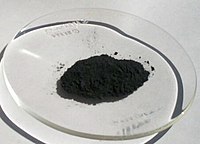
Photo from wikipedia
Reduced graphene oxide–Zn0.5Ni0.5Fe2O4 ferrite–polyaniline nanocomposite (RGO–ZNF–PANI) was synthesized by a three-step method. The prepared samples were characterized by x-ray diffraction, Raman spectroscopy, scanning electron microscopy and vibrating sample magnetometer. In… Click to show full abstract
Reduced graphene oxide–Zn0.5Ni0.5Fe2O4 ferrite–polyaniline nanocomposite (RGO–ZNF–PANI) was synthesized by a three-step method. The prepared samples were characterized by x-ray diffraction, Raman spectroscopy, scanning electron microscopy and vibrating sample magnetometer. In particular, we found that this material is capable of effectively removing uranium from an aquatic environment. This is confirmed by our experimental results using the method of inductively coupled plasma mass spectrometry. Adsorptive behaviour of uranium from an aqueous solution on the RGO–ZNF–PANI nanocomposite was examined as a function of pH, contact time, and equilibrium. Uranium concentration was carried out by batch techniques. The adsorption isotherm agrees well with the Langmuir model, having a maximum sorption capacity of 1885 mg/g, at pH 5 and 25°C.
Journal Title: Journal of Electronic Materials
Year Published: 2017
Link to full text (if available)
Share on Social Media: Sign Up to like & get
recommendations!